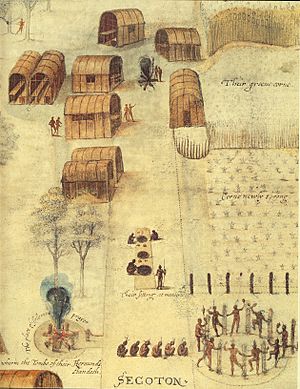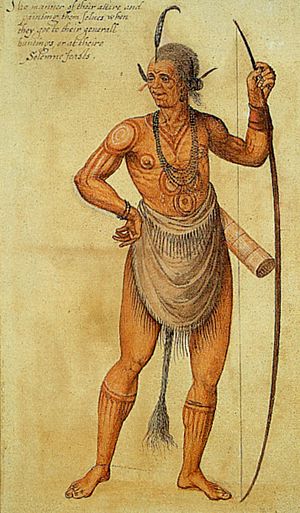Dasamongueponke facts for kids
| Total population | |
|---|---|
| Extinct as a tribe | |
| Regions with significant populations | |
| North Carolina | |
| Languages | |
| Carolina Algonquian language | |
| Religion | |
| Tribal religion (historical) | |
| Related ethnic groups | |
| Secotan, Aquascogoc |


The Dasamongueponke (also called Dasamonguepeuk) was a Native American tribe. They were part of the Secotan people. Their village was also called Dasamongueponke. English settlers met them in the late 1500s. This was when the English tried to build colonies in what is now North Carolina. At that time, this area was known as Virginia.
The Dasamongueponke were part of a larger group called the Carolina Algonquian Indians. They spoke the Carolina Algonquian language, which is now extinct. The name Dasamongueponke in their language means "where the extended land is surrounded by water."
Roanoke Colony Encounters
In 1585, Sir Richard Grenville led an expedition. This group tried to settle English people on Roanoke Island. Later, a war started between the Secotan people and the English. King Wingina, a Native American leader, used the Dasamongueponke village as a base. From there, he planned attacks on the English colony.
When Grenville left Roanoke, he left behind fifteen soldiers. In 1587, Governor John White returned to the island. He looked for these fifteen men. But he only found their bones. White soon met friendly Native Americans led by Chief Manteo. Manteo explained that the fifteen soldiers had been killed. They were attacked by warriors from the Secotan, Aquascogoc, and Dasamongueponke tribes. Manteo said the attack happened at a time and place that gave the Native Americans a great advantage.
On August 8, 1587, Governor White led an attack. It was meant to be on the Dasamongueponke village. But it went very wrong. White and his soldiers entered the village early in the morning. It was still dark. They mistakenly attacked a group of friendly Native Americans. They killed one person and wounded many others. White wrote in his journal, "We were deceaved, for the savages were our friendes." After this mistake, relations with the local tribes became much worse.
Chief Manteo was later given a special title. He became a baron, the Lord of Roanoke and Dasamongueponke. He was the first person given such a title by the English in North America.
Historical Records and Legacy
Most of what we know about the Dasamongueponke tribe comes from Governor John White. He kept a journal and made many watercolor paintings. In 1585, he was asked to "draw to life" the people and places of the New World.
While on Roanoke Island, White created many detailed drawings. These showed the landscape and the Native American people. These artworks are very important. They are the best pictures we have of a Native American society from the Eastern coast in the 1500s. They show us what life was like before other famous explorers like Captain James Cook sailed. White's paintings are the only visual record left of the Native Americans met by England's first settlers.
White's choice to use watercolors was unusual for his time. Most painters preferred oil paints. His watercolors became very popular in Europe. Soon, a Flemish artist named Theodore de Bry made engravings of White's paintings. These engravings were published in 1590 in a book called "America." This helped spread knowledge of White's work far and wide.

